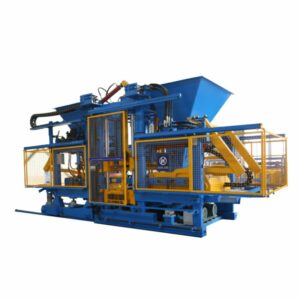Using a block making machine offers several advantages over traditional manual methods of block or brick production. These advantages include increased efficiency, improved quality, reduced labor, and enhanced versatility. Here are some of the key benefits of using a block making machine:
- Higher Production Rate: Block making machines can produce blocks or bricks at a much faster rate compared to manual methods. This is especially beneficial for large-scale construction projects where a high volume of building units is needed.
- Consistency in Quality: Block making machines ensure consistent block dimensions and quality. Manual methods are prone to variations in size and density, which can affect the structural integrity of the construction.
- Enhanced Strength: Machine-pressed blocks are compacted under controlled pressure, resulting in higher compressive strength. This makes them suitable for load-bearing and structural applications.
- Versatility: Block making machines are versatile and can be configured to produce various block types, sizes, and shapes, including solid blocks, hollow blocks, interlocking blocks, and decorative blocks. Manual methods may have limited versatility.
- Cost Savings: Although block making machines have an initial investment cost, they can lead to significant cost savings in the long run. These savings come from reduced labor costs and improved efficiency in the production process.
- Reduced Labor Dependency: Using a block making machine requires fewer laborers compared to manual methods, where a large workforce is often needed for mixing, molding, and stacking blocks. This can reduce labor expenses and improve worker safety.
- Improved Health and Safety: Manual block production can be physically demanding and pose health risks to workers, especially when handling heavy materials. Block making machines reduce the physical strain on workers and enhance safety.
- Environmental Benefits: Block making machines can be designed to use recycled materials in block production, promoting sustainability and reducing waste. This aligns with environmentally friendly building practices.
- Precise Block Dimensions: Machines ensure precise block dimensions, allowing for tight tolerances and exact measurements. This is essential for projects that require precision and consistency.
- Automation and Control: Block making machines can feature automation and computerized controls, allowing for precise control over the entire production process. machine block for sale This minimizes human error and ensures uniform block quality.
- Conservation of Resources: Block making machines optimize the use of raw materials, reducing waste and saving resources. The accurate proportioning of materials minimizes material excess.
- Efficient Curing: Some block making machines include integrated curing systems that optimize curing conditions, leading to faster and more efficient solidification of the blocks.
- Customization: Machines can be configured and customized to meet specific project requirements, such as block size, shape, and color.
- Reduced Maintenance and Repair: Well-maintained block making machines typically have longer lifespans and require less maintenance compared to manual equipment.
In summary, block making machines offer numerous advantages, such as increased production efficiency, higher quality, cost savings, and reduced labor dependency. These benefits make them valuable tools for construction projects of all sizes, from small-scale ventures to large infrastructure developments.
What is a block making machine, and what is its primary purpose in construction and manufacturing?
A block making machine, also known as a block machine or brick making machine, is a piece of equipment used in construction and manufacturing to produce concrete blocks or bricks. Its primary purpose is to efficiently and precisely manufacture blocks or bricks of various types and sizes for use in construction projects. Block making machines can produce solid or hollow blocks, interlocking bricks, paving stones, and other building units used in the construction of walls, pavements, and other structures.
The main components and functions of a block making machine include:
- Hopper: A storage compartment for raw materials such as cement, sand, aggregate, and water. The hopper accurately measures and proportions the materials for mixing.
- Mixer: Mixes the raw materials with water to create a uniform and workable mixture. The quality of the mix is crucial for the strength and quality of the blocks.
- Mold or Die: The mold or die is where the mixed material is placed and compacted to shape it into blocks or bricks. Molds can be customized for different block types and sizes.
- Vibrator: Vibrators are used to compact the material within the mold, ensuring that it is free of air voids and has a uniform density.
- Hydraulic System: Many block making machines use hydraulic systems to apply pressure to the molds. Hydraulic force helps compact the material and release the blocks from the molds.
- Conveyor Belt: A conveyor system transports the mixed material from the hopper to the mold and also conveys the newly formed blocks to a curing area.
- Control Panel: A control panel allows operators to set parameters, control machine functions, and monitor the block making process.
The primary purpose of a block making machine in construction and manufacturing is to:
- Produce high-quality, standardized blocks or bricks used for building walls, pavements, and other structures.
- Increase production efficiency, as block making machines can produce blocks at a much faster rate compared to manual methods.
- Ensure consistency in block dimensions, quality, and strength, which is crucial for the structural integrity of the constructed buildings.
- Reduce labor and manual effort, as block making machines automate many of the tasks involved in block production.
- Offer versatility by allowing the production of various block types and sizes, meeting diverse construction needs.
Block making machines are widely used in the construction industry, ranging from small-scale construction projects to large infrastructure developments. They play a crucial role in producing building materials that are essential for the construction of homes, commercial buildings, and public infrastructure.
